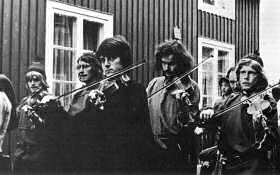|
The 20th century
 Young
fiddlers from Norrbotten in the north of Sweden on their way to a
"spelman" gathering. Young
fiddlers from Norrbotten in the north of Sweden on their way to a
"spelman" gathering.
Photo: Rikskonserter.
Around the turn of the century the migration from the countryside into
the towns had gathered speed considerably. The functions of folk music,
both for dancing and as a way of mixing socially, were gradually taken
over by modern popular music. But a number of people saw the worth of
the old folk culture and tried in one way or another to preserve it.
"Spelman" competitions were organized, leading in turn to "spelman"
gatherings where many musicians played together. Previously a "spelman"
played solo or together with at most two colleagues.
Fiddlers ensembles were started in many districts, in some cases with 30
members or more. The old music was arranged in parts and to a certain
extent changed character. Today many districts in Sweden have fiddlers
ensembles – called "spelmanslag" – and many of these ensembles include
accordionists. The ensembles are affiliated county by county to
associations, most of which are in turn affiliated to "Sveriges Spelmäns
Riksförbund" – the National Folk Musicians' Association of Sweden.
In recent years the youth of Sweden have become interested in their own
folk music. Today there are many able young folk musicians, both male
and female, many of which attempt to rediscover older ways of playing
which have been kept alive by older musicians in isolated areas outside
the realm of the fiddlers ensembles. Others try to give a new lease of
life to the music of their locality, which was perhaps almost
exterminated by the religious revival of the 19th century. Many try to
discover new ways of putting folk music to use. Swedish folk music is in
other words in a very healthy state: all the young musicians and singers
ensure that it will at least live into the 21st century. |